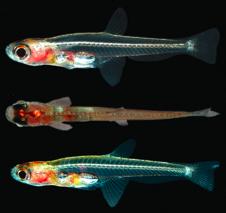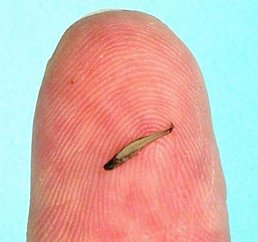
They just keep getting smaller. Barely a month after scientists identified the world's smallest species of frog, this little guy has been snapped relaxing on an US dime. At 7.7 millimetres long from snout to tail, it's even teenier than December's "smallest frog ever" - and this time it's the smallest vertebrate, too.
Paedophryne amauensis was discovered in Papua New Guinea in 2009 by Christopher Austin of Louisiana State University in Baton Rouge and colleagues. They have now published an official description.
P. amauensis is slightly smaller than the previous smallest vertebrate, a Sumatran fish called Paedocypris progenetica that was described in 2006. Females of this species grow to 7.9 mm.
There is another contender for the title of smallest vertebrate: one kind of male anglerfish is just 6.2 mm long. But this particular male lives his entire life attached to the (much larger) female, and his body is little more than a backbone and a pair of testicles - so many biologists feel he shouldn't count.
Regardless, the new frogs are just the latest in a parade of tiny animals discovered in recent years.
Back in 1996, the title of smallest frog was held by two species from Brazil and Cuba, both just 10 mm long.
In 2001, a tiny gecko was found that's just 16 mm long - giving it the joint record for world's smallest reptile, along with a closely-related species.
Then, in 2008, we found out about Leptotyphlops carlae: the world's smallest snake, barely as thick as a strand of spaghetti.
And just last month, we were told about two species of frog that measured just 8-9 mm.
Austin thinks that miniature frogs are not just oddities and may be quite common. He points out that 27 of the 29 smallest frogs skip the tadpole phase and hatch straight into adults, and also live in very moist areas. These factors may make it easier for smaller frogs to evolve. For instance, tiny frogs have a large surface area-to-volume ratio, which puts them at risk of losing a lot of water through their skin. The moist environment may help avoid dehydration.
How much smaller can they go? The new miniature frogs have simplified body plans compared to their larger cousins: they have fewer vertebrae in their backbones, and fewer digits on their feet. It's not clear how much more they could lose and still survive as free-living animals, but we're willing to bet the race is on to find one that measures just 6 mm long. Check back here in, oh, about one month's time.
Journal reference: PLoS ONE, DOI: 10.1371/journal.pone.0029797
Story Here
Last month's story on the previous record holders here




